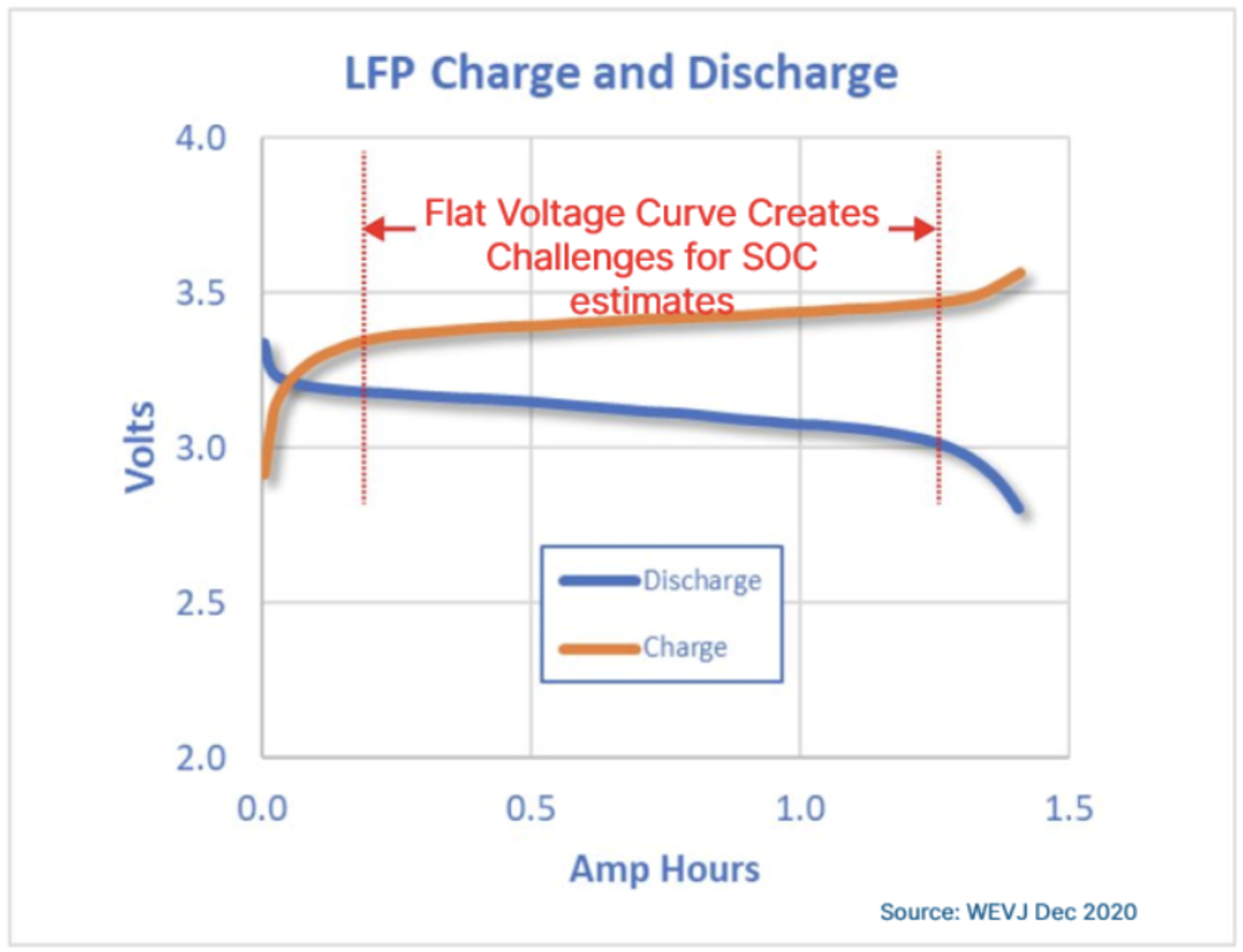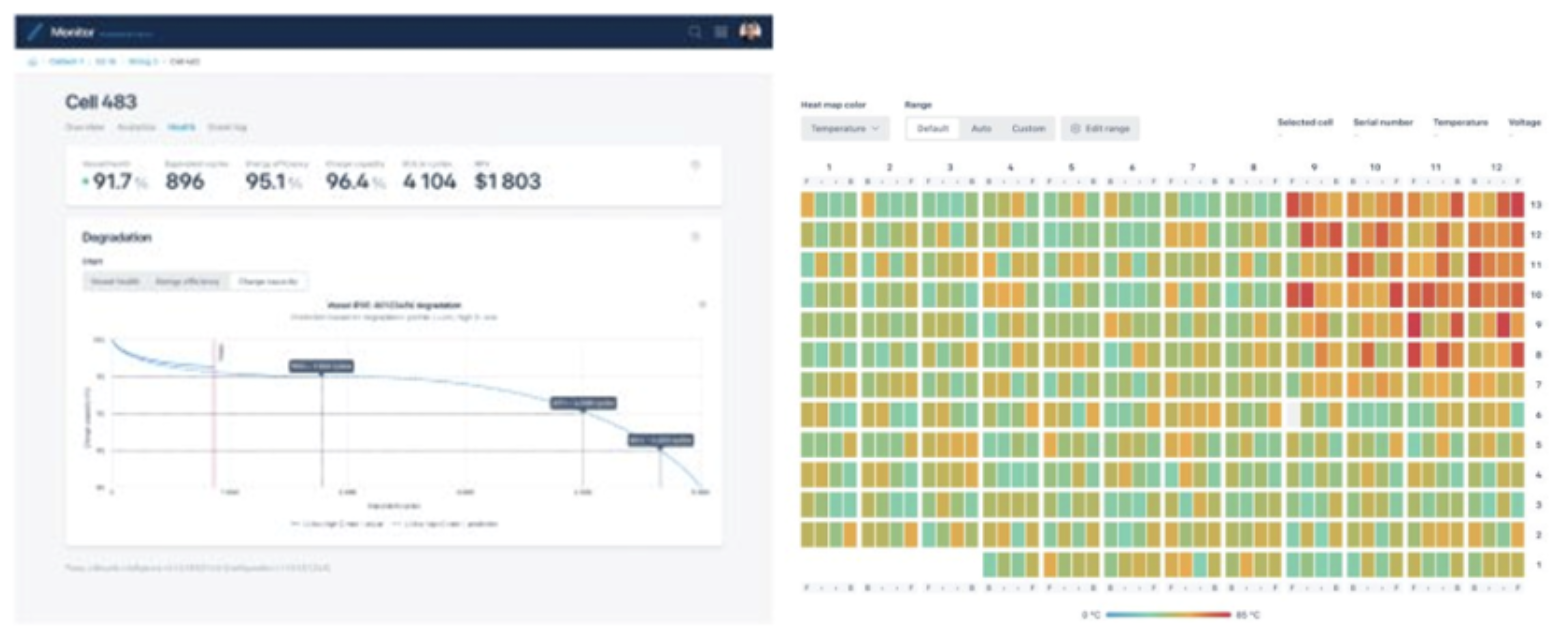Battery analytics can help the entire battery value chain, including material suppliers, battery OEMs, system integrators, and owners and operators of battery energy storage systems (BESS) to maximize value, reliability, and safety. It also plays an important role in enabling further growth of the energy storage market itself, which is expected to reach 741 GWh by 2030 in the US and Europe, according to Wood Mackenzie. This is possible by providing insights beyond those offered by a battery management system (BMS), typically supplied by the battery OEM. In this issue, we’ll look in detail at what some of the benefits are.
One of the key aspects of battery analytics for battery owners and operators is improving the estimated State of Charge (SOC) and State of Health (SOH) for each battery cell or module through a predictive battery analytics solution. As most readers are already aware, SOC is defined as the available capacity (in Ah) expressed as a percentage of its rated capacity, while SOH is defined as a measure of the battery’s capacity to store and deliver electrical energy, compared with a new battery’s initial capacity. Both SOC and SOH are influenced by various factors such as temperature, current, voltage, cycling, aging, and calendar life. The actual values can also vary in definition as a “failure” depending on manufacturer warranties, for example, which may only cover batteries that continue to hold at least ~60-70% of their capacity for ten years.*
Improving the estimated SOC and SOH of batteries is crucial for several reasons. First for SOC, it can help optimize charging and discharging strategies to avoid overcharging or over discharging, which can cause permanent damage to the internal structure of batteries. Second, it can help balance the state of charge of each cell or module in a battery pack or system, to prevent uneven degradation and improve the overall performance. Third, it can improve energy trading by accurately bidding the available BESS capacity. For SOH, it can help forecast the remaining useful life (RUL) and residual value (RV) of batteries, which can inform investment decisions such as augmentation and forecast life cycle revenue models. Finally, improved SOC and SOH can help detect inconsistent battery behavior and prevent safety issues such as thermal runaway, fires, or explosions, which can result from excessive heat generation, gas formation, or internal short circuits in batteries.
Peaxy Battery Analytics measures battery performance by ingesting a variety of data including configuration and telemetry data, BMS registers, and real-time computations to report on anomalous temperatures, voltage, degradation and SOH as shown in the examples above. More advanced computational models and machine learning algorithms ensure a higher quality result vs. a BMS alone.
To estimate SOC and SOH accurately, a battery analytics solution employs sophisticated algorithms that can account for the complex chemical and physical processes involved in battery operation. Some of the common methods used for SOC and SOH estimation are coulomb counting, voltage method, impedance spectroscopy, Kalman filter method, neural network method, fuzzy logic method and machine learning. Each method has its advantages and limitations depending on the battery type, application, and operating conditions.
In addition to SOH and SOC estimators, some of the common metrics used in battery monitoring include voltage, current, and temperature. A robust battery analytics platform can ingest, normalize and parameterize a multitude of data from various sources into one common source of trust, using either physical sensors or existing API’s that preclude deployment of additional hardware. Battery monitoring tools that can take advantage of this data help to measure and track the key battery metrics that affect the performance and lifespan of the battery. For example, voltage sensors can detect overcharging or undercharging conditions, current sensors can measure the power output and input of the battery, temperature sensors can monitor the thermal stability and efficiency of the battery, and SOH and SOC estimators can calculate the remaining capacity and health of the battery based on various factors.
By using the tools and charts generated by an automated system that can easily traverse enormous amounts of data, a battery monitoring system can provide a more sophisticated and yet cost effective way to optimize the charging and discharging cycles, prevent damage or degradation, and extend the life and improve the performance of the battery. With the significant investment that a BESS requires to manufacture, install and operate, an effective battery analytics solution just makes economic sense.
SOH and SOC monitoring is a valuable tool for asset managers who want to improve the financial return of their battery systems by optimizing the safety, performance, dispatch and lifespan of the batteries. By monitoring the health and charge status of the batteries, the system can identify potential issues from a macro level and recommend preventive actions before they occur with the ability to drill down into the metrics using the same system. Such a solution can also help to reduce operational costs and environmental impact by minimizing battery degradation and waste.
SOC and SOH measurements are also useful in manufacturing battery energy storage systems to optimize the BMS to ensure that when batteries are assembled into modules or packs, they are operating within efficient limits, including voltage, current and temperature. It can further assist during balancing to improve the performance, reliability, and safety of the battery pack, either through a passive approach where excess energy is dissipated from overcharged cells as heat, or active which transfers excess energy from higher to lower cells using switches, capacitors, transistors and transformers. In many cases, the methods chosen for optimal balancing topology, and the measurements that inform it, are driven by cost and speed. Only a dedicated battery analytics solution can provide the cloud computing and complex algorithms necessary to deliver the best and most accurate results at high volumes, ultimately leading to improved financial performance.
SOH scoring has been a boon to several customers who adopted our solution during development of their grid connected storage solutions. In one case, SOH trending was used to dramatically aid the analysis of design of experiments, specifically while optimizing electrolyte recipes over a range of temperature domains. In a second, SOH scoring during commissioning identified outlier modules in a fashion that was both automated – the customer needed no analysis other than what PLI provided – and customer configurable.

Peaxy Battery Analytics improves existing lithium iron phosphate (LFP) SOC and SOH estimating and degradation forecasting with machine learning. Combining measurements from Voltage Open Circuit (VOC) and Coulomb Counting (CC), Peaxy’s Machine Learning Manager updates standard degradation curves based on actual dispatch, adjusts curves based on stressful dispatch and alerts for high c-rate, calendar aging, temperature variation, etc.
Peaxy’s battery analytics solution, which leverages advanced data science and machine learning techniques to provide near real-time insights into SOC and SOH for batteries used in energy storage, can provide remote monitoring capabilities across a portfolio of energy storage systems, enabling owners and operators to track key performance indicators (KPIs), identify anomalies, diagnose issues, optimize operations, and plan maintenance from a single view.
The Takeaway
Peaxy’s battery analytics platform can help BESS owners and operators achieve financial and operational benefits such as:
– Increased energy output and revenue by optimizing charge/discharge cycles and maximizing depth of discharge (DoD), minimizing voltage rebalancing requirements, and improving accuracy in energy trading BESS capacity.
– Reduced operational costs and risks by minimizing chances of over-charging or over-discharging, identifying unusual battery behavior, extending battery life, and preventing safety incidents.
– Enhanced asset management and planning by forecasting RUL and RV, identifying optimal augmentation and end of life timing, and enabling secondary market transactions.
Battery monitoring within a comprehensive battery analytics solution is a game changer for energy storage applications, as it can provide accurate estimation of SOC and SOH, which are essential parameters for optimizing performance, reliability, safety, and value. Our solution backed by battery knowledge experts can provide significant benefits with energy output, operational costs, asset management, and planning.
* https://www.altenergymag.com/article/2017/09/understanding-battery-degradation/27102


